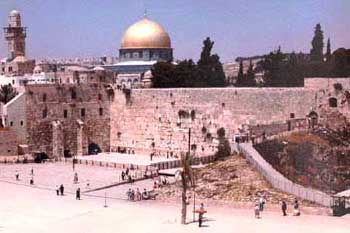The Road to Jerusalem
 |
| Driving up the main road from the airport or Tel Aviv into the mountains, Jerusalem welcomes you with an inspiring blend of old and new. In 2008, the city unveiled the new "Jerusalem Chords Bridge" - a high tech lightrail bridge over the city entrance that is built to the style and shape of a harp, the famous musical instrument of Israel's great King David. Designed to add a defining visual element to the city skyline, much like San Francisco's Golden Gate Bridge, the Empire State Building in Manhattan or the Champs-Elysées of Paris, the Chords Bridge blends the biblical history of Jerusalem with its modern flare. The entrance to Jerusalem is still pretty abrupt, though; one minute you're on the highway and the next you've been transported to a different world. Almost immediately you find yourself on narrow streets with low-level buildings, many dating back decades and some even containing holes from where bullets struck them during various wars. The sidewalks are typically filled with people scurrying about, ultra-orthodox Jews or hasidim in their distinctive garb, university and high school students, soldiers with automatic rifles casually slung over one shoulder with a knapsack over the other. The unparalleled mixture of the ancient and modern, the secular and religious is apparent at once. You feel that something is different and, intellectually and spiritually, you know this is a place unlike any other. One of its many unique qualities is that Jerusalem almost completely shuts down on Shabbat. This is a time of incredible quiet, like nothing you can experience in any other major city, when the observant Jews head for the Western Wall, synagogues and family gatherings, and less observant Jews enjoy their one day off from work, spend the day with their families, relax and take in the breathtaking beauty of the city. A handful of restaurants stay open and people still roam the streets, but most activity ends mid-day Friday and doesn't pick up again until after dark on Saturday. Jerusalem is the largest city in Israel and the nation's capital. It is a place where you can have fun, but it is more spiritual than spirited. Of course, sometimes the spirit moves people a little too far. In fact, psychologists have identified something they call the "Jerusalem syndrome" to describe people who become so intoxicated with the city they act irrationally, sometimes to the point of believing themselves to be the messiah. For purposes of this tour, we’ve divided the city into four sections. The first offers an overview of the city's long and rich history. This includes a discussion of the current controversy over the future of the city. The next stop is the Old City, roughly 220 acres surrounded by walls built by Suleiman the Magnificent in the 16th century. This is the heart of the city and has both political and religious significance. The Old City is divided into quarters — Jewish, Armenian, Muslim and Christian. The holiest place for Jews is the Western Wall in the Jewish Quarter. Two of Islam’s most important shrines, the Dome of the Rock and al-Aqsa Mosque are in the Muslim Quarter on the Temple Mount. The Church of the Holy Sepulcher in the Christian Quarter is revered by Christians as the site of the death, burial, and resurrection of Jesus Christ. Here you can imagine life centuries ago and even walk on original 2,000-year-old stones. The neighborhoods beyond the Old City walls include Yemin Moshe, the first Jewish neighborhood built outside the walls, which is identifiable by its distinctive – and unusable – windmill; Mount Scopus, home of the Hebrew University; the Mount of Olives, the site of several important Christian shrines and the cemetery where Jews have buried their dead for centuries and Mea She’arim, an island in time where ultra-Orthodox Jews dress and behave in traditional ways and strictly observe Jewish law. The "new" city is the more modern part of Jerusalem that was mostly built after Jordan occupied the Old City and the rest of the eastern half of the city following the 1948 war. This is where Israel has established most of its government offices, including the Knesset and the magnificent new Supreme Court building. It is also where you can find the world-renowned Hadassah Hospital, with its famous Chagall windows; Mt. Herzl, the final resting place of most of Israel’s leaders and Yad Vashem, Israel museum and memorial to the Holocaust. Most visitors stay in this part of the city, which also has beautiful parks and a lively downtown with clubs, shops and restaurants. For believers, this is the place where the call to God is a local one. For everyone else, it is a place of great beauty and history that is unlike anywhere else on earth. |
| Previous | Next |



